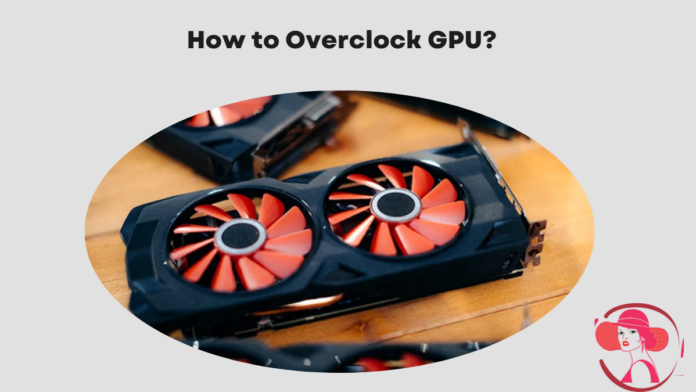Overclocking your GPU (Graphics Processing Unit) can significantly enhance your gaming experience by boosting your frames per second (FPS) and overall graphics performance. This process involves increasing the clock speeds of your GPU beyond the manufacturer’s settings to achieve better performance.
While it might sound daunting, with the right tools and careful steps, you can safely overclock your graphics card to get the most out of your hardware. Here is an article on how to overclock GPU:
What is Overclocking?
Overclocking increases the operating speed of a computer component, such as the GPU, beyond its factory-set specifications. Doing so can improve your GPU’s performance, allowing for higher FPS in games and smoother overall graphics rendering.
However, it is important to note that overclocking can also lead to increased power consumption and heat output, which means you need to proceed with caution and ensure proper cooling and power supply.
How to Prepare for Overlooking?
Here is how to prepare for overlooking:
- Before starting, ensure your GPU and cooling system can handle the additional load. A good aftermarket cooler or a well-ventilated case can make a significant difference.
- Make sure your GPU drivers are up to date. Manufacturers like NVIDIA and AMD frequently release updates that can improve performance and stability.
- Use benchmarking tools like 3DMark or Unigine Heaven to measure your current GPU performance. This gives you a baseline to compare against after overclocking.
- Tools like MSI Afterburner or HWMonitor can help you monitor your GPU’s temperature and overall system stability during overclocking.
How to Overclock GPU?
- Programs like MSI Afterburner, EVGA Precision X, or AMD Radeon WattMan are popular choices for GPU overclocking. These tools allow you to adjust clock speeds, monitor temperatures, and test stability.
- Start by increasing the core clock speed in small increments, typically 10-20 MHz. After each adjustment, run a benchmark to test stability and performance. If your system crashes or you encounter graphical artefacts, reduce the clock speed slightly and test again.
- Like the core clock, increase the memory clock speed in small increments and test after each adjustment. Memory overclocking can improve texture loading times and overall game performance.
- Once you find stable settings for both core and memory clocks, you can fine-tune by adjusting the voltage (if your software and GPU allow it). Increasing the voltage can improve stability and generate more heat, ensuring an adequate cooling solution.
- After finding a stable overclock, run extended stress tests using tools like FurMark or Prime95 to ensure your GPU remains stable under long load periods. Monitor temperatures closely and ensure they stay within safe limits (typically below 85°C for most GPUs).
Tips for Safe Overclocking
Here are some tips for safe overclocking:
- Always make changes in small increments to avoid damaging your hardware.
- Keep a close eye on your GPU temperature. Overheating can cause instability and potentially damage your GPU.
- Ensure your system has adequate cooling. Consider additional case fans or an upgraded GPU cooler if temperatures are too high.
- Make sure your power supply unit (PSU) can handle the increased power draw. Overclocking can significantly increase power consumption.
- Be aware that overclocking can void your GPU’s warranty. Check your manufacturer’s policy before proceeding.
Troubleshooting common overclocking Issues
Even with careful planning, overclocking can sometimes lead to unexpected issues. One common problem is system instability, which can manifest as crashes or graphical artefacts during gameplay or stress testing. If you encounter these issues, try reducing the clock speeds in smaller increments until stability is restored.
Another issue is overheating, which can be addressed by improving your cooling setup. Ensure your GPU fans are functioning properly, and consider adding more case fans or upgrading to a better cooling solution. Monitoring tools can help identify and resolve these problems before they cause permanent damage.
How to Overclock GPU
After successfully overclocking your GPU, maintaining it properly is crucial to ensure long-term performance and stability. Regularly clean your PC to prevent dust buildup, which can hinder cooling. Keep your drivers updated to benefit from the latest performance improvements and bug fixes.
Periodically re-run benchmarks and stress tests to ensure your overclock remains stable. If you notice any degradation in performance or stability, re-evaluate your settings and make adjustments as necessary.
Also, consider using software to create custom fan curves, optimising cooling based on your usage patterns.
Benefits and risks of overclocking
Here are some benefits and risks of overclocking:
Benefits:
- Higher FPS and smoother gameplay.
- Better rendering of textures and faster loading times.
- It extends the life and performance of your current GPU without needing to be upgraded.
Risks:
- Higher temperatures can reduce the lifespan of your GPU if not properly managed.
- Overclocking can significantly increase power usage.
- Incorrect settings can cause crashes, graphical artefacts, or hardware failure.
Conclusion
Overclocking your GPU can provide significant performance gains and enhance your gaming experience. By following the steps outlined above, you can safely push your graphics card beyond its factory settings to achieve better FPS and smoother gameplay.
Some Questions
What is GPU overclocking?
GPU overclocking is all about increasing the clock speeds of your graphics card to enhance performance beyond factory settings.
Is overclocking safe?
Overclocking is generally safe if done in small increments with proper cooling and monitoring. However, it does carry risks, such as increased heat and potential hardware damage.
What tools do I need for overclocking?
Popular tools include MSI Afterburner, EVGA Precision X, and AMD Radeon WattMan, which allow you to adjust clock speeds and monitor temperatures.
How do I know if my GPU is stable after overclocking?
Use benchmarking and stress-testing tools to ensure stability. If your system crashes or shows graphical artefacts, slightly reduce clock speeds and test again.
Can overclocking void my GPU warranty?
Yes, overclocking can void your GPU’s warranty. Check with your manufacturer before proceeding.
Read More















